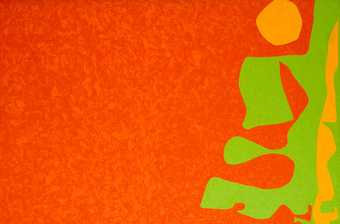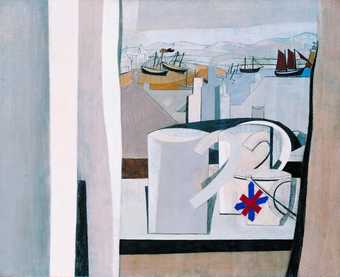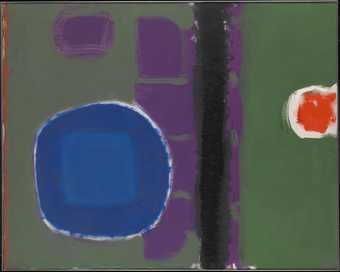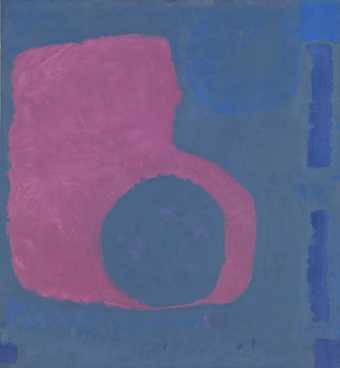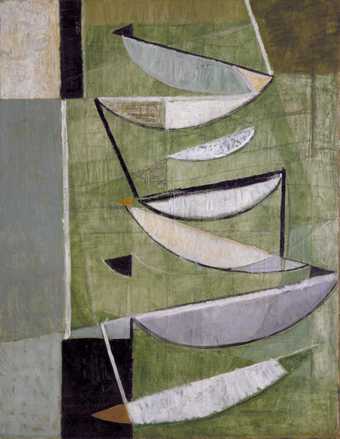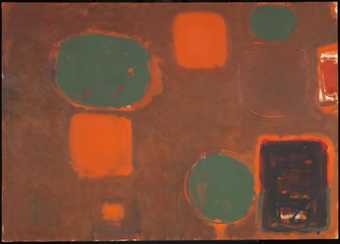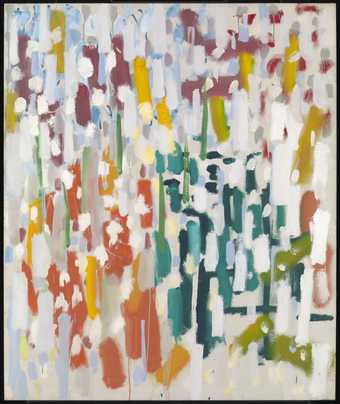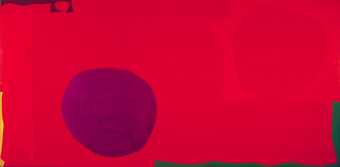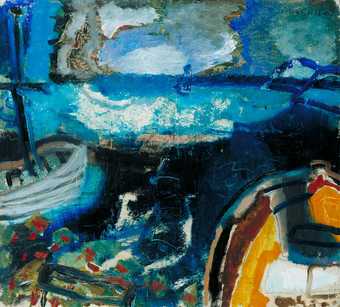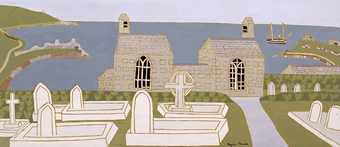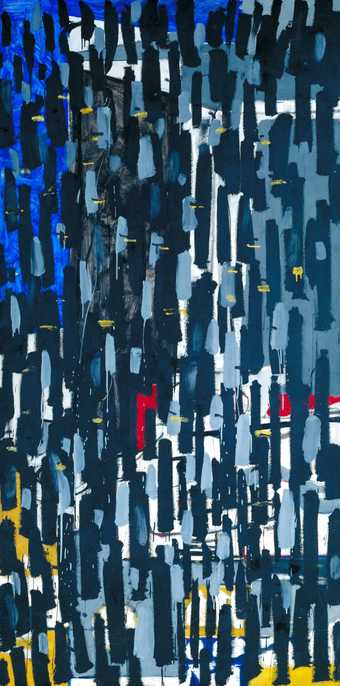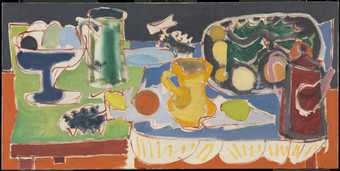
In Tate St Ives
- Artist
- Patrick Heron 1920–1999
- Medium
- Oil paint and charcoal on hardboard
- Dimensions
- Support: 1219 × 1524 mm
- Collection
- Tate
- Acquisition
- Purchased 1980
- Reference
- T03106
Catalogue entry
T03106 HARBOUR WINDOW WITH TWO FIGURES, ST IVES: JULY 1950 1950
Inscribed ‘Patrick Heron 50’ top right
Oil on board, 48 × 60 (122.9 × 152.3)
Purchased from Miss Susanna and Miss Katherine Heron, the artist's daughters (Grant-in-Aid) 1980
Exh: Patrick Heron, Humphrey Spender, Fred Uhlman, Redfern Gallery, October–November 1951 (1); Retrospective Exhibition of Paintings and Drawings by Patrick Heron, City Art Gallery, Wakefield, April–May 1952 and subsequent tour to University of Leeds, May; Bankfield Museum, Halifax, May–June; Art Gallery, Scarborough, July–August; Ferens Art Gallery, Hull, August–September 1952 (56, repr.in colour); Tio Engelska Målare, Riksförbundet för Bildande Konst/British Council touring exhibition, Sweden 1953–4 (19, repr.); Patrick Heron: New Paintings, Redfern Gallery, May–June 1954 (23, repr.in colour); Retrospective: Patrick Heron, Richard Demarco Gallery, Edinburgh, June–July 1967 (26, repr.in colour); Cornwall 1945–1955, New Art Centre, November–December 1977 (53); Patrick Heron: Paintings 1950–55 and 1970–77, Waddington Galleries, February–March 1979 (works not numbered, repr.)
Repr: Studio, CXLI, 1951, p.134 in colour
Patrick Heron wrote in a letter dated 27 April 1983 as follows:
'“Harbour Window with Two Figures, St Ives: July 1950”’
'The above is the full correct title of this painting as it appears under the large colour plate made of it by Lund Humphries for Cresta Silks, who used it for a Christmas card...
'This painting was the largest, and the most ambitious, in my 1951 exhibition at the Redfern Gallery, from the walls of which it was removed at the request of the Trustees of the Tate Gallery for consideration for purchasing, but returned after a week. It might, therefore, have entered the Tate's collection 30 years earlier than it did.
'Most of the other paintings in the 1951 Redfern show were even more complicated, and far more linear, than “Harbour Window”, which was slightly earlier. Up to 1950 the dominant obsession was, of course, the open window, usually with a table top seen in front of it, or indeed half a room or even the bend of a staircase providing the space on the inside of the window. The feeling of a sort of marriage of indoor and outdoor space, through the aperture of the window frame, itself roughly rectilinear and parallel to the picture surface, was really the main theme of all my paintings - or nearly all - between 1945 and 1955. And the window in the vast majority of them was this harbour window, looking out across a balcony over the harbour and bay from the studio cottage, perched right on the sea-wall itself, which Delia and I rented from Mrs Pauline Hewitt (an academic St Ives painter who was at least 30 years older than ourselves) every year from 1947 (our eldest daughter, Katharine, had her first birthday party in front of that window) until 1954. We rented it for two or three months in each of those years, but hardly ever at the same time of the year. I shall never forget the immense sensation of space the first moment we entered that room, at the end of our journey from London: it was an October night and a full moon was rising over Godrevy. The very last figurative work I made, which was in 1954, was a memory of this moment - it consists of a black and white drawing in charcoal on primed canvas, but this was the window occurring over and over again in my paintings of that period, whether we were actually in St Ives when I painted them, or at home at Addison Avenue, Holland Park. I probably painted more St Ives harbour window paintings in London than in Cornwall. However, your picture, which I think is the best of the entire series, was actually begun in St Ives and three-quarters finished, and was then taken to Addison Avenue to be completed. My habit of drawing in charcoal on a white ground, and then slotting the planes of scribbled colour in between the grid of charcoal drawing, was still the procedure followed here. It's possibly worth noting that the freshness of this painting's surface, after 33 years, looks like being the result of my having sprayed it with fixative soon after it was completed. The fixative acts like a varnish over the paint. Also established at the time I painted it was my habit of only applying one coat of colour over the white ground, which seems to be responsible for the brilliance of hue- there are one or two areas, very noticeably, where I have applied more than one colour - on the side of the armchair at the left, on the wall under the window just over the table, and in the sea in the middle of the right hand window panel.
'I think it's important to point out that, although the subject is at St Ives, the entire idiom of this painting, and of all my paintings then and later, was totally unrelated to any painting ever made in Cornwall. It was largely based on the French masters I so much admired, and which I was alone (with William Scott) in England, let alone Cornwall, in being influenced by at that time - Matisse, Braque, Bonnard. From Braque came the idea of the “transparency” of the objects: for instance the line of the carpet flows right through both the armchair, the legs of the nude figure (Delia), the table, as well as a near chair-back, and the figure of my daughter Katharine: the figure in the bottom right is a portrait of Katharine at the age of 2 or 3 clutching her teddy-bear! On the other hand, the nature of my charcoal drawing is far removed from Braque; for instance, there is not a single rigidly straight line, nor a pure arc or circle; in their loose and speedy linearity these charcoal grids are, therefore, if anything, nearer Matisse-although I would have thought that they are perhaps personal and rather English.
'Years later I returned to rapidly drawing the linear structure which defines the edges of the colour areas in my paintings. To my surprise it was pointed out to me at the Whitechapel exhibition of my very large paintings, in 1972, by both William Scott and Hilton Kramer, that in their linear character the big Whitechapel canvases (of 1969–72) contained an echo of my “Braque” period of the Forties and early Fifties.’
Published in:
The Tate Gallery 1980-82: Illustrated Catalogue of Acquisitions, London 1984
Explore
- abstraction(8,615)
-
- from recognisable sources(3,634)
- non-representational(6,161)
-
- irregular forms(2,007)
- pier(360)
- formal qualities(12,454)
- domestic(1,795)
-
- living room(292)
- furnishings(3,081)
- jug(228)
- girl(1,079)
- Heron, Delia(1)
- Heron, Katharine(1)
- individuals: female(1,698)
- UK cities, towns and villages(12,725)
-
- St Ives(167)
- Cornwall(1,034)
- England(19,202)
- England, South West(3,507)
- England, Southern(8,982)
- boat, fishing(337)
You might like
-
Patrick Heron Scarlet, Emerald, and Orange : July-September 1976
1976 -
Ben Nicholson OM 1943-45 (St Ives, Cornwall)
1943–5 -
Patrick Heron Green and Purple Painting with Blue Disc : May 1960
1960 -
Patrick Heron Purple Shape in Blue : 1964
1964 -
Patrick Heron Scarlet, Lemon and Ultramarine : March 1957
1957 -
Sir Terry Frost Green, Black and White Movement
1951 -
Patrick Heron Horizontal Stripe Painting : November 1957 - January 1958
1957–8 -
Patrick Heron Brown Ground with Soft Red and Green : August 1958 - July 1959
1958–9 -
Patrick Heron Azalea Garden : May 1956
1956 -
Patrick Heron Cadmium with Violet, Scarlet, Emerald, Lemon and Venetian : 1969
1969 -
Patrick Heron Boats at Night : 1947
1947 -
Bryan Pearce St Ives from the Cemetery
1975 -
Patrick Heron Vertical : January 1956
1956 -
Patrick Heron The Long Table with Fruit : 1949
1949 -
Patrick Heron Yellow Painting : October 1958 May/June 1959
1958–9

